How to Create Podcast Show Notes To Encourage Action & Growth
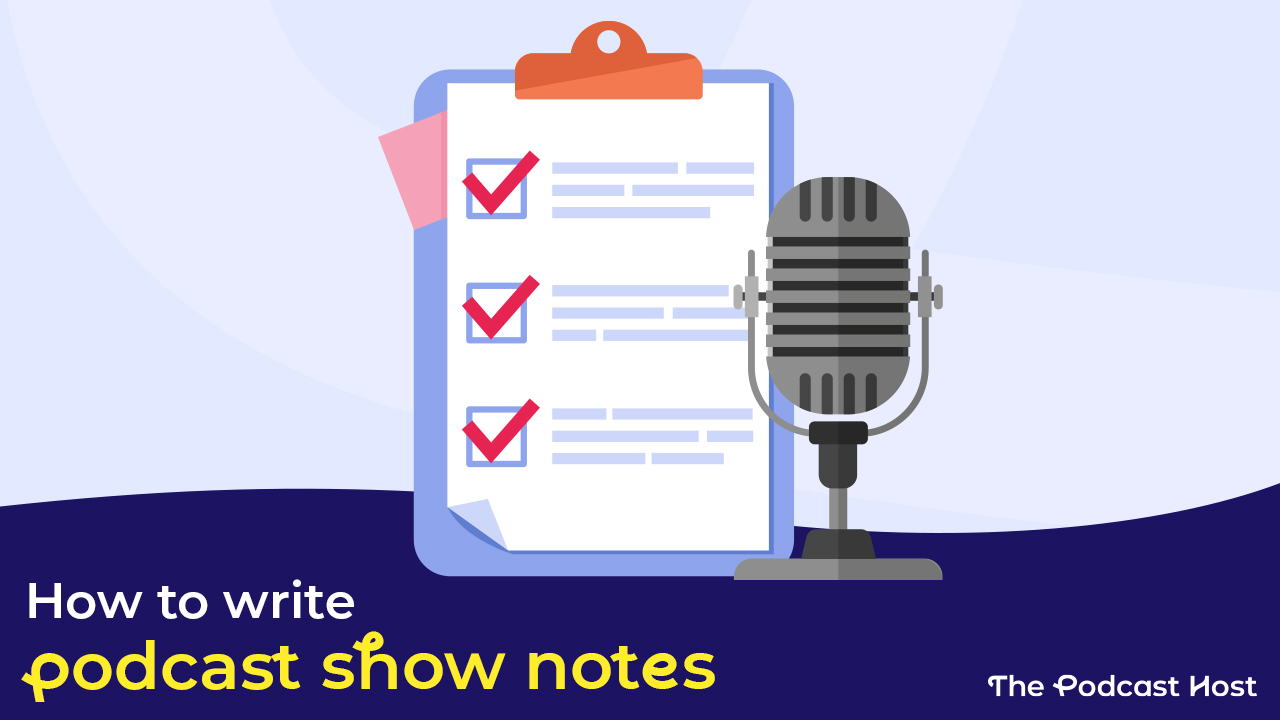
Podcast show notes are one of those tasks that you KNOW are essential, but you can never bring yourself to love it. After all, you’ve done the fun stuff: planning content, playing with your kit, and recording a show.
That should be it, right?
‘Fraid not! Here’s a question we got last week to kick us off.
Can you advise me on my podcasting website. How should show notes work? Do I just set them up like a blog? Unsure how this works. Don’t want to set something up only to have to re-do it.
The short answer is yes. Podcast show notes are nothing more than a blog post with an audio file attached. But they’re also so much more than that. Let’s delve a little deeper – what are podcast show notes for, and how do we put them together?
What are Podcast Show Notes For?
Podcast show notes serve three main purposes. The first two serve existing listeners:
1. To offer a summary of the show content – either to persuade someone to listen, or to remind a previous listener what was covered.
2. To offer links to resources, people or products that were mentioned. You can’t link within the show itself, so you offer the links on the show notes.
The last serves you, and those who have yet to listen:
3. To attract new listeners through search traffic.
That last one is the one most podcasters neglect. You’ll find a lot of podcasters throwing up show notes that are nothing more than a very quick introduction paragraph and then a list of the resources that were mentioned. That’s fine, as a minimum. It serves your listener, covering #1 and #2. But, if that’s all you do, you’re missing a trick in growing your audience.
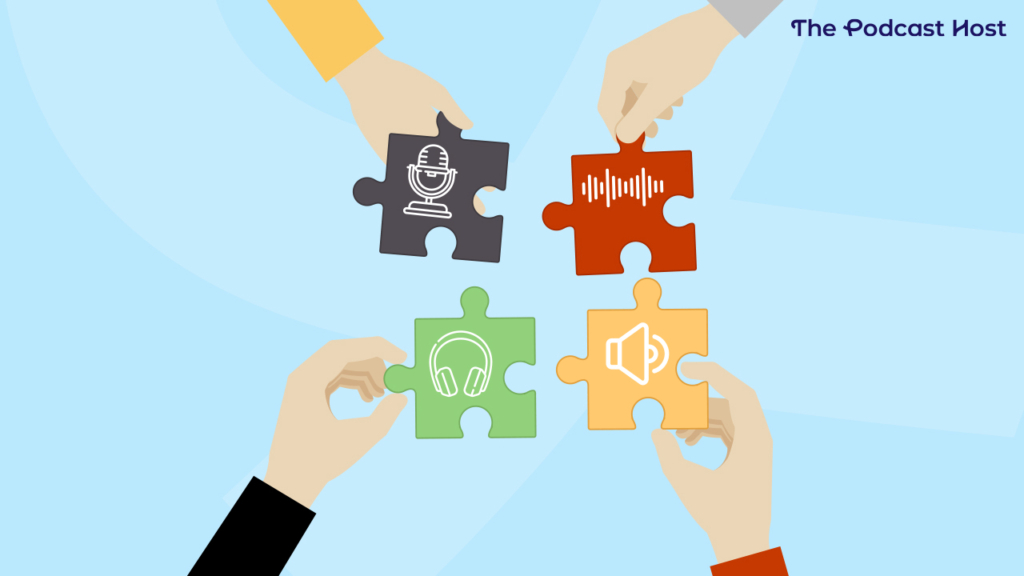
How Show Notes Can Grow Your Audience
A good set of show notes can attract legions of potential new listeners by appearing in the search results.
How do you do that?
By writing a blog post that covers the same topic as the podcast.
That blog post acts as a written version of the show. Not a direct transcript, but something created to be read. It contains the same valuable information as the podcast, and encourages readers: “If you liked this, then listen to the podcast episode for even more.”
Often in the podcast, you’ll tell more stories about it, give more examples, and that might be the extra value that gains you a new listener. Even if you don’t add anything extra, many people will appreciate being given an audio version to listen to at another time.

Example Show Notes: a Best Practice Format
Here’s the best practice show notes format we often use, and which you can build from:
- Episode Summary – a paragraph or bullet points
- Episode Player – embed from your host
- Timecode guide – list highlights and timecodes to skip to
- Full Topic guide – a blog post, essentially, covering the same topic
- Resources mentioned – summary & links to all resources and transcription
Let’s cover each element in a little more detail.
1. Episode Summary
Start with a brief summary of the episode – either a one or two paragraph introduction or a set of bullet points. This gives the listener the lowdown on what you’re covering and can help casual visitors decide whether it’s worth listening to. This is important – show the problem you’re solving to really engage with the listener, and persuade them to listen!
2. Episode Player
Then below that, we’ll have the audio player, generated in whatever podcast host you normally use. This allows easy listening for casual visitors, or a simple way to review the content for subscribers.
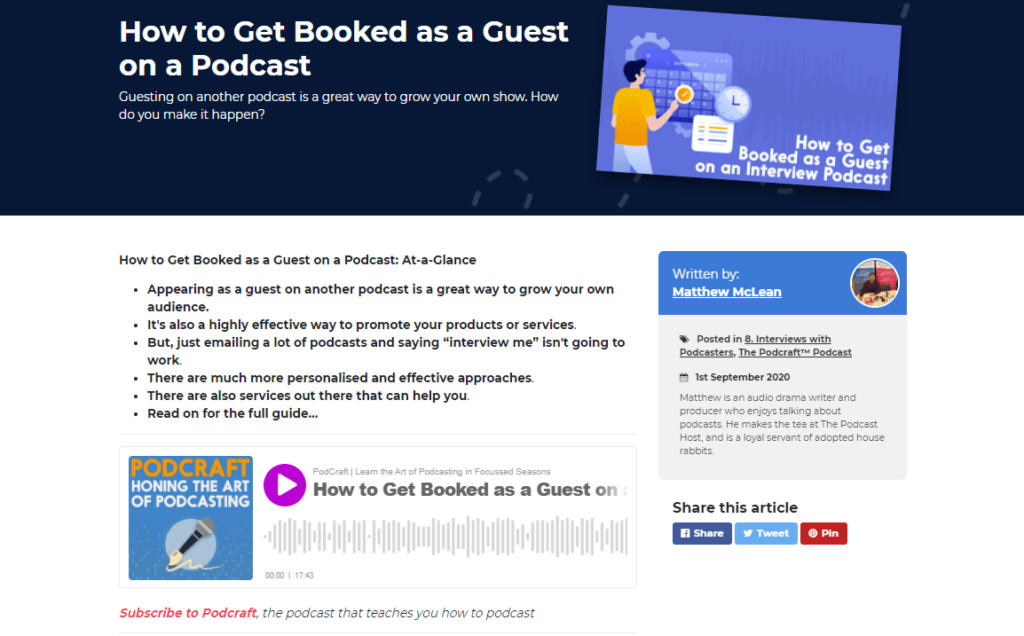
3. Timecode Guide
This takes a bit of effort, so it’s more “icing on the cake” than essential, but it’s hugely useful to listeners. And anything useful to listeners is a thing worth doing for audience growth!
A timecode summary picks out the highlights of the episode, and lists when they happen, in the audio. This allows casual visitors to pick out the most relevant parts and get value immediately. If they can do that, they’re far more likely to subscribe or follow!
And for followers? It allows them to go back to the episode and re-listen to the parts they really engaged with. Again, most value for the listener, more success for the listener, and more loyalty to you!
For example, an excerpt here from This Week in Startups, a podcast that does a great summary every week:
- …
- 39:02 OurCrowd – Sign up for a free account at https://www.ourcrowd.com/twist
- 40:46 Dick Costolo’s responds to infamous & now-deleted tweet on Acquired’s recent Twitter episode – was taking the tweet down the right move?
- 45:57 Thoughts on the proper way to do civil discourse at work
- 54:23 Jason in hot water with Bernie Bros due to recent pro-gig economy tweet, thoughts on Prop 22 & more
- 1:07:07 DOJ antitrust lawsuit against Google, Apple ramps up development of their own search engine as Google partnership in hot water
- 1:10:40 Acquired’s Top 10 Acquisitions of all time
- 1:15:34 Deep dive on the Google/Apple partnership, how the Android acquisition saved Google billions of dollar per year
- …

3. Full Topic Coverage (Blog Post)
Next, below the player, you go into full detail, covering the episode’s main points and a little explanation around them. Within that extra detail, link to resources mentioned within the show. That means people can easily find anything you say in the audio.
The purpose of this is two-fold.
First, it means the article is genuinely useful on its own, even without the audio. So, searchers are much more likely to find it via Google, skim the content, and perhaps end up subscribing to the show. This is one of your biggest growth opportunities since text search reaches a wider audience than podcast search.
Second, this makes your show notes so valuable to existing subscribers or followers. They can, at any time, visit this page to review all the material, re-learn it, and pick out elements to put into action right away. With all of this info right on the page, easily skimmable, you help your listeners so much more. And that’s what builds loyal fans!
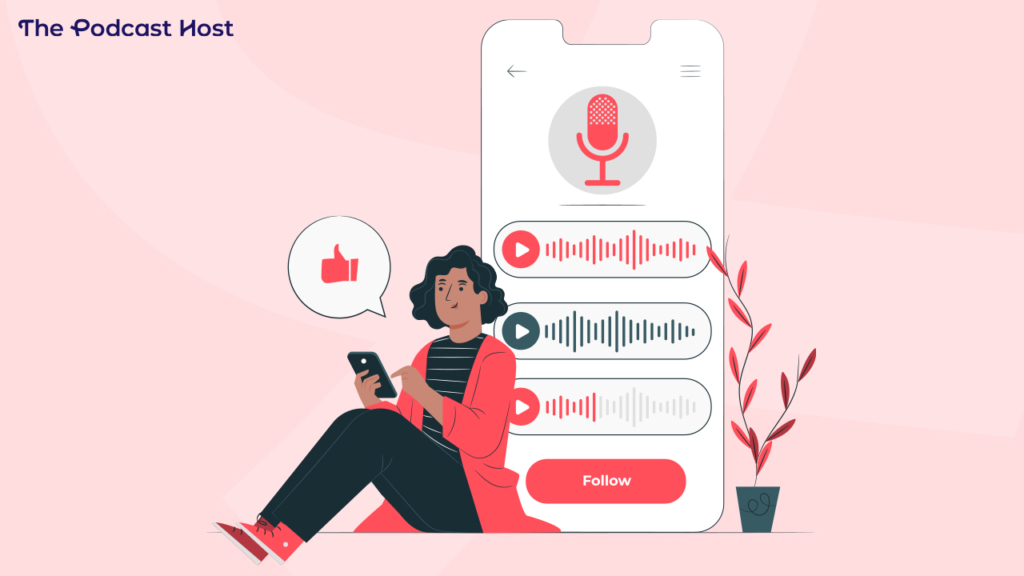
4. Resource List
I mentioned resource links above, but it’s great to include a list of the main resources and links right at the start or the end of the blog section so that links are all nicely collated and easily found. This is one of the biggest uses of shownotes for existing subscribers – to pop in and find out exactly what “That amazing app he mentioned…” was and to nip over there.
Including great resource links, every time, will encourage repeat visits to your shownotes.
Other Elements, Like Video?
You can go further than this, turning your podcast show notes into a massive fan-building, conversion-creating multi-media experience. Read about that full content stacking approach here. If you can put the time into this, it can be a game-changer for your business.
Keeping Show Notes Short: Sacrifice Content for Sustainability?
Some people can’t find the time to do full blog-post style show notes every week. So, an alternative is to keep ’em shorter and forget about the search engine benefits. Just focus on giving value to your existing subscribers.
In this case, do the 50-word intro paragraph or bullet points, and then some resource links and related descriptions. You could even dispense with the descriptions altogether and just list links. If you can, the timecode summary is super-useful, even if you find two or three of the big highlights to allow your visitors to skip through.
Comparing the two, the long blog-post style format offers much more value in content marketing. The show notes, acting like blog articles, start to gain traffic since they’re much more likely to be found and indexed well in the search results. On the other hand, there’s no point getting that extra value if it’s unsustainable.
If the effort of full-blog show notes stops you from podcasting altogether, then you get absolutely no benefit at all. In that case, it’s better to do less and get the show out regularly. This is a balance between time and total benefit.
I think it can depend a lot on the context, particularly whether the podcasting website is brand new, or whether the podcast is being added to an existing website. In the case of a brand new podcasting website, the show notes are even more worth investing time into as they’ll start to build out the written content and give the site some meat. Adding very thin podcast show notes pages to an already thin website will unlikely help the site gain any authority.
In contrast, a well-established site can stand to gain a few thin pages, and you can spend time on your wider blogging instead for that content benefit. On the other hand, if you tie your blogging and podcasting efforts together through a content stacking approach, I’d argue that you can do both for more benefit and less effort in the long run!

Can you use a Transcription as your Podcast Shownotes?
Here’s a third possibility. If you’re really short of time, transcriptions might be worth considering. You can pay around $1.50 per minute to get a full human transcription of any show from Rev. If you’re doing quite short, focused episodes, these transcriptions can be very useful and readable for your listeners. As a bonus, they provide nice, long, meaty content for the site with little extra time and effort – just a bit of cost. Of course, you can create AI-generated transcriptions for much less (sometimes, free), but the trade-off is that they’ll take more editing time.
If you did that, you’d only have to write a 50-word intro para yourself, then add the transcription after the player. You can go through the transcription and add links where appropriate to make sure the listener can find the relevant resources. Although, in this case, a collated resource link list may be useful so the reader doesn’t have to trawl a long transcription.
On the downside, the spoken word often doesn’t translate well into a written form. Unedited transcriptions can often be long, rambling and made up of terrible English. It’s surprising how often we don’t speak in complete or correct sentences! In this case, a transcription might not offer much value.
It depends on your speaking style, though, and how you present. Solo shows tend to provide more useful transcriptions, while a conversation can just look like a confusing mess on paper. It’s an approach worth trying, but it won’t work for everyone!
Hiring a Podcast Show Notes Writer
If you don’t have the time, or simply don’t want to write your own podcast show notes, then you might want to outsource them altogether. If that’s the case, then we recommend mediasips or mabendroth15 on Fiverr. You can get thorough and excellent show notes there for as little as $13.
Our Fiverr links are affiliates, but these are show note writing services we’ve used ourselves and were really happy with the results. That’s why we recommend them!
Using ChatGPT to Create Draft Show Notes
AI tools are on the rise, and ChatGPT is the biggest of them all.
There are many different ways ChatGPT can be useful to podcasters, and drafting show notes is one of them.
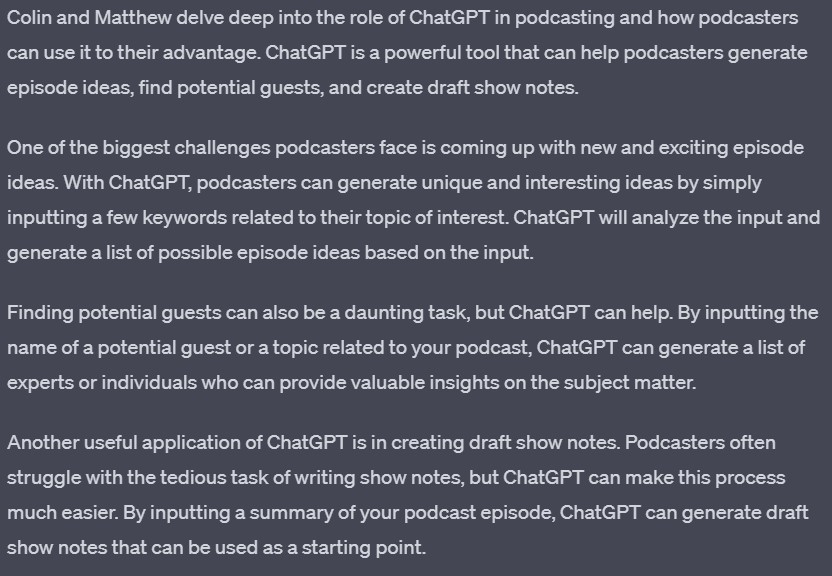
This doesn’t excuse you from writing anything, though. The value is all in the prompt, so the more info you can give ChatGPT about the episode’s content, the better its output will be.
You’ll also still need to do a bit of editing to the draft ChatGPT creates for you. It would be bad practice to copy and paste this right into your show notes field without putting a bit of your own spin on it first. But it’s undoubtedly a huge helping hand for folks who hate writing show notes, or just hate writing in general.

Need More Help?
If you’re keen to master show note writing yourself, check out Podcraft Academy. There you can download The Podcast Show Notes Cookbook – your ultimate guide to writing podcast show notes of all kinds.

And you’ll find loads more in the Academy on top of that. We hold weekly live Q&A sessions and have courses on everything from planning and presenting to monetisation and promotion. It’d be great to see you there!
